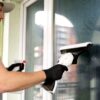In the heart of architectural marvels and progressive urban planning, Abu Dhabi stands as a testament to the fusion of tradition and modernity. Amidst the soaring structures and futuristic designs, a silent hero plays a pivotal role in not just preserving these buildings but also contributing to the broader vision of sustainable urban living. Silicon replacement, often viewed as a routine maintenance task, emerges as a catalyst for energy efficiency in Abu Dhabi. In this exploration, we uncover the intricate relationship between silicon replacement and sustainable construction practices, shedding light on how this seemingly routine process can be a transformative force in the city’s journey toward energy efficiency.
Silicon replacement in Abu Dhabi
Understanding the Role of Silicon in Building Efficiency
Silicon in Seals and Joints
Silicon, a versatile material, is commonly used in the construction industry as a sealant in joints. Its primary function is to create a barrier, preventing water ingress and maintaining the integrity of the structure. In Abu Dhabi’s challenging climate, characterized by extreme temperatures and occasional sandstorms, the wear and tear on silicon are accelerated. As silicon ages, its effectiveness diminishes, leading to potential energy inefficiencies due to compromised building envelopes.
The Impact of Aging Silicon on Energy Efficiency
Aging or deteriorating silicon can lead to gaps and cracks in seals and joints, allowing conditioned air to escape and external elements to penetrate. This compromises the building’s insulation and puts a strain on heating, ventilation, and air conditioning (HVAC) systems. The consequence is an increase in energy consumption as HVAC systems work harder to maintain desired indoor temperatures. Recognizing the role of silicon in maintaining energy efficiency becomes crucial for sustainable and cost-effective building operation.
The Nexus Between Silicon Replacement and Energy Efficiency
Eco-Friendly Silicon Alternatives
As the construction industry in Abu Dhabi embraces sustainability, silicon is not just a matter of routine maintenance but an opportunity to enhance energy efficiency. Explore the latest eco-friendly silicon alternatives that not only provide robust sealing but also contribute to a reduction in the overall carbon footprint of buildings. Our commitment to sustainable silicon replacement services aligns with Abu Dhabi’s vision for environmentally conscious construction practices.
Thermal Insulation through Silicon Replacement
Delve into the thermal insulating properties of modern silicon materials. Silicon replacement goes beyond mere maintenance; it becomes a strategic step in improving the thermal performance of buildings. By utilizing silicon materials with enhanced insulating capabilities, structures in Abu Dhabi can reduce dependency on HVAC systems, leading to significant energy savings and improved overall efficiency.
Precision Application Techniques for Optimal Performance
The efficacy of silicon in enhancing energy efficiency lies in the precision of application. Investigate advanced application techniques that ensure seamless sealing, leaving no room for energy-wasting gaps or leaks. From meticulous surface preparation to the use of cutting-edge application equipment, our silicon replacement services prioritize precision to maximize energy efficiency gains.
Case Studies: Demonstrating Energy Efficiency Gains
Before and After: Energy Audits
Highlight specific case studies where silicon replacement has been a catalyst for remarkable improvements in energy efficiency. Discuss the process of conducting energy audits before and after silicon replacement, showcasing tangible reductions in energy consumption and costs. These real-world examples underscore the transformative impact of strategic silicon replacement on the overall sustainability of buildings in Abu Dhabi.
LEED Certification and Energy-Efficient Silicon Replacement
Explore projects where silicon replacement has played a pivotal role in achieving LEED (Leadership in Energy and Environmental Design) certification. Discuss the correlation between energy-efficient silicon and the criteria set forth by LEED, emphasizing how this approach contributes to the broader goal of sustainable and energy-efficient construction in Abu Dhabi.
Conclusion
In concluding our exploration of silicon replacement as a catalyst for energy efficiency in Abu Dhabi, it becomes evident that routine maintenance can be a powerful driver of sustainable urban living. The strategic replacement of silicon in seals and joints transcends the conventional understanding of maintenance, emerging as a proactive step towards energy efficiency. As Abu Dhabi continues its journey towards a greener and more sustainable future, silicon stands at the intersection of preserving architectural heritage and optimizing building performance for the generations to come.





